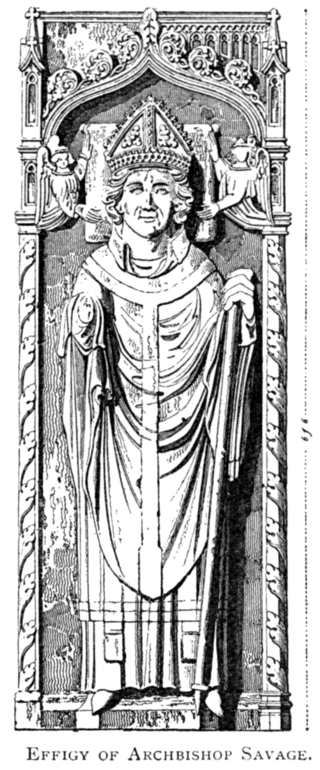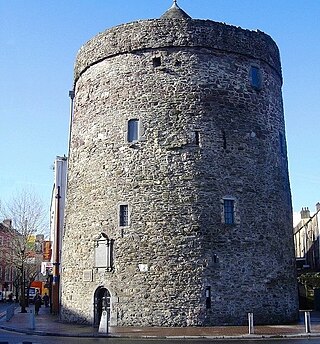Related Research Articles

Henry VII was King of England and Lord of Ireland from his seizure of the crown on 22 August 1485 until his death in 1509. He was the first monarch of the House of Tudor.
Year 1495 (MCDXCV) was a common year starting on Thursday of the Julian calendar.

Perkin Warbeck was a pretender to the English throne claiming to be Richard of Shrewsbury, Duke of York, who was the second son of Edward IV and one of the so-called "Princes in the Tower". Richard, were he alive, would have been the rightful claimant to the throne, assuming that his elder brother Edward V was dead and that he was legitimate—a point that had been previously contested by his uncle, King Richard III.

James IV was King of Scotland from 11 June 1488 until his death at the Battle of Flodden in 1513. He inherited the throne at the age of fifteen on the death of his father, James III, at the Battle of Sauchieburn, following a rebellion in which the younger James was the figurehead of the rebels. James IV is generally regarded as the most successful of the Stewart monarchs. He was responsible for a major expansion of the Scottish royal navy, which included the founding of two royal dockyards and the acquisition or construction of 38 ships, including the Michael, the largest warship of its time.

Sir Edward Poynings KG was an English soldier, administrator and diplomat, and Lord Deputy of Ireland under King Henry VII of England.
John Atwater was an Irish merchant and Mayor of Cork known for his support of Perkin Warbeck, a pretender to the English Crown following the Wars of the Roses. Atwater was a prominent Yorkist supporter opposed to the rule of the Tudor Dynasty led by Henry VII.
Thomas Ruthall was an English churchman, administrator and diplomat. He was a leading councillor of Henry VIII of England.
Sir James OrmondaliasButler was the son of John Butler, 6th Earl of Ormond. He was Lord Treasurer of Ireland from 1492 to 1494, and helped to defend the Lordship of Ireland against the forces of Perkin Warbeck. He was murdered by Sir Piers Butler on 17 July 1497. Piers would later hold the title of Earl of Ormond.

Thomas Savage was a prelate, diplomat and scholar during the Tudor period. Savage served as Chaplain to King Henry VII and was Archbishop of York from 1501 until his death in 1507. Prior to his consecration as a Bishop, Savage served as a diplomat and rector. As a diplomat Savage held the positions of English Ambassador to Castile and Portugal, during which time he helped broker the marriage treaty between Arthur, Prince of Wales and Catherine of Aragon in 1489, and later held the position of English Ambassador to France from 1490, where he took part in the conference at Boulogne.
Richard Harliston, became a yeoman of the king's chamber on the accession of Edward IV. He was made vice-admiral, in which capacity he came to Guernsey.
Roger Machado was an English diplomat and officer of arms of Portuguese extraction. He lived among the Portuguese merchants at Bruges in 1455.
Events from the 1490s in England.
The Second Cornish uprising occurred in September 1497 when the pretender to the throne Perkin Warbeck landed at Whitesand Bay, near Land's End, on 7 September with just 120 men in two ships.
Don Pedro de Ayala also Pedro López Ayala was a 16th-century Spanish diplomat employed by Ferdinand II of Aragon and Isabella I of Castile at the courts of James IV of Scotland and Henry VII of England. His mission to Scotland was concerned with the King's marriage and the international crisis caused by the pretender Perkin Warbeck. In his later career he supported Catherine of Aragon in England but was involved in a decade of rivalry with the resident Spanish ambassador in London. Ayala was a Papal prothonotary, Archdeacon of London, and Bishop of the Canary Islands.
John Payne, Bishop of Meath, held that office from 1483 until his death in 1506; he was also Master of the Rolls in Ireland. He is best remembered for his part in the coronation of Lambert Simnel, the pretender to the Crown of England, in 1487.

John Wyse was an Irish judge who held office as Chief Baron of the Irish Exchequer.

Reginald's Tower is a historic tower in Waterford, Munster, Ireland. It is located at the eastern end of the city quay. The tower has been in usage for different purposes for many centuries and is an important landmark in Waterford and an important remnant of its medieval urban defence system. It is the oldest civic building in Ireland and it is the only urban monument in Ireland to retain a Norse or Viking name.

Sir John Savage, KG, KB, PC (1444–1492), was an English knight of the Savage family, who was a noted military commander of the late 15th-century. Savage most notably fought at the Battle of Bosworth Field in 1485, where he commanded the left flank of the Tudor (Lancastrian) army to victory and is said to have personally slain the Duke of Norfolk in single combat. Earlier in the Wars of the Roses, Savage had been a supporter and friend of the Yorkist King Edward IV, fighting alongside him and helping him to victories at the Battle of Barnet in 1471 and the Battle of Tewkesbury later that same year, as well as joining the Duke of Gloucester's invasion of Scotland in 1482, where the Duke made him a Knight banneret. However, following the death of Edward and the Duke of Gloucester's ascension to the throne as Richard III the Savage family was viewed with suspicion due to their familial connection to the Stanleys, who were in turn connected to the Tudors. Consequently Savage was one of the prominent figures who invited Henry Tudor to invade England in 1485, a struggle which culminated in the Battle of Bosworth Field. After his victory Henry Tudor received the circlet of Richard from Savage's uncle Lord Stanley and was crowned King of England on the field of battle, taking the throne as Henry VII of England.
The siege of Boulogne took place during the autumn of 1492. Henry VII of England had led an expeditionary force of 12,000 troops across the Channel to Calais and began to besiege the French port of Boulogne on 18 October. After several weeks the siege was broken off when Henry and the French monarch Charles VIII agreed to the Peace of Étaples. The siege had proved to be a successful show of force and Henry was offered very favourable terms by Charles, including the end of French support to the pretender to the English throne Perkin Warbeck, Warbeck was also expelled from the country. The terms of the treaty also included the English accepting French control of Brittany, and the French paying Henry an indemnity of 742,000 crowns, payable at 50,000 crowns per annum, equivalent to 5% of the crown's annual income. Henry had been in negotiations even before the campaign, and the move against Boulogne may have been intended to put further pressure on Charles.

An eleven-day Siege of Waterford took place, in Waterford in 1495, after the pretender to the throne of Henry VII, Perkin Warbeck's failed attack on Deal, Kent. Warbeck was joined by Cork's Maurice FitzGerald, 9th Earl of Desmond when they went to Ireland and launched an invasion of Waterford on 23 July 1495.
References
- ↑ Porter p.110
- ↑ "1495 siege of Waterford". 19 April 2019.


